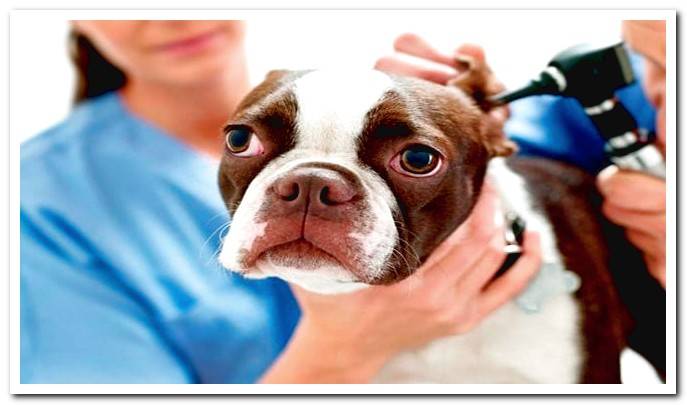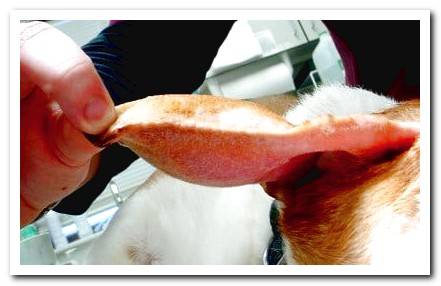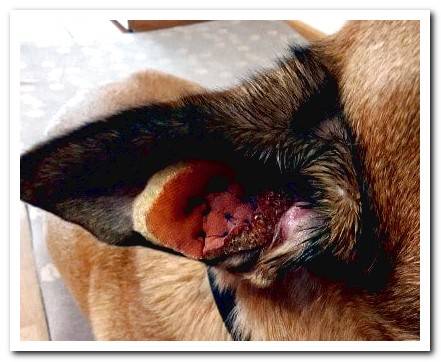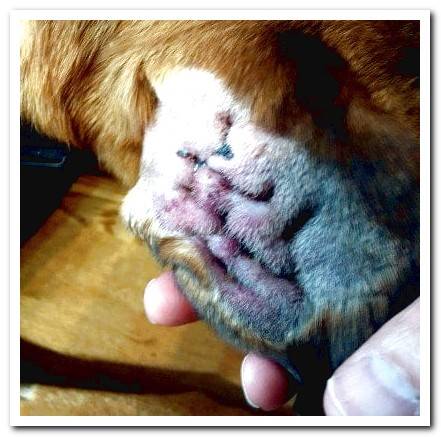
Otohematoma is a fairly common problem in dogs, especially those with droopy ears or who commonly suffer from otitis. It is a very easy pathology to detect, since our dog’s ear can become “swollen” as if it were a balloon.
Treatment should be as immediate as possible to avoid complications such as infections or permanent deformations of the dog’s ear. Next, we will explain the main causes, their treatment and the guidelines to follow to prevent this ear problem in our pet.
Index of contents
- 1 What is an Otohematoma?
- 2 How does an otohematoma occur?
- 3 What factors cause Otohematomas?
- 4 What factors predispose to suffer Otohematomas?
- 5 How is an Otohematoma diagnosed?
- 6 What is the treatment for an Otohematoma?
- 7 What guidelines should be followed after an Otohematoma operation?
What is an Otohematoma?
An otohematoma is a bruise located in the dog’s pinna that is, an accumulation of blood between the skin and the atrial cartilage. The dog’s ears are like a sandwich: a layer of skin, ear cartilage, and another layer of skin; and between these layers there are blood vessels.
The main problem is that there are hardly any blood vessels in the dog’s ear and the reabsorption of this blood can be complicated and accumulate in the form of a kind of bag.
Initially, only is an accumulation of liquid blood and serum But over time, if not treated, clots form that can cause permanent scarring of the dog’s ear and other secondary complications such as atrial cartilage infections (perichondritis).
How does an otohematoma occur?
Direct trauma to our dog’s ear, scratching of the ears, or repeated shaking of the head, can cause the rupture of blood vessels in the pinna. This causes the outflow of blood that accumulates under the skin of the ear (between the skin and the cartilage), causing a fluctuating bulge in the flag that will be of different sizes depending on the amount of extravased blood.
If we let the time pass without going to the vet, new trauma to the area (such as scratching or shaking), can cause a new hemorrhage to restart and increase the size and severity of the process.

What factors cause Otohematomas?
As we have seen, the cause of otohematomas is the rupture of the blood vessels of the pinna. This break usually occurs for 3 reasons:
- Direct trauma to the ear area (hitting, fighting between dogs)
- Repeated autotraumatisms due to scratching or shaking of the head due to itching or earaches from underlying pathologies (otitis, allergies, parasites)
- Fragility of blood vessels in older dogs (increases the risk of bleeding even if there is no significant trauma to the area).
What factors predispose to suffer Otohematomas?
In addition to the aforementioned, these factors can make your dog more predisposed to suffer an otohematoma.
- Ears Type: Otohematomas are more common in lop-eared dogs.
- Sex: the incidence of otohematomas is higher in males than in females.
- Age: The incidence of otohematomas increases with age due to the fragility of the blood vessels in these dogs.
- Recurrences: otohematomas they can leave sequels in the area, being common that there are recurrences in dogs that have undergone this process previously.
- Underlying pathologies: Dogs that have pathologies that cause pain or itching in the auricular area are more likely to develop otohematomas due to repeated autotrauma (scratching or jerking).
How is an Otohematoma diagnosed?
The display of a fluctuating bulging in a dog’s pinna is an obvious sign of otohematoma. The diagnosis is confirmed by draining / emptying its contents by aspiration with a needle and syringe, confirming that it is blood. Always done by a vet.


What is the treatment for an Otohematoma?
For the treatment of an otohematoma to be successful and not to appear again, the first thing that the vet must determine is the underlying cause that caused it and treat it (otitis, allergy, parasites); since if the trauma to the atrial area continues, even if we remove the otohematoma, it will reappear.
Not all otohematomas are caused by otitis problems or underlying itching. There may be capillary fragility or trauma as the main cause, and in these cases, the measure to take after eliminating otohematoma is to take extreme precautions to avoid future trauma to the ears.
To remove the otohematoma itself, you have to follow the following veterinary procedure :
- If it is a small otohematoma and it is not a recurrence Drainage of the contents by needle and syringe aspiration may solve the problem. The administration of corticosteroids and antibiotics may be necessary to avoid complications.
- If it is a more severe otohematoma or a recurrence, the resolution must be surgical. The technique is based on making an incision to drain the entire hematoma and performing a thorough cleaning of the pinna and the external ear canal. The type of incision made is special (the edges are trimmed), to prevent it from closing in the following days and allowing the wound to drain. On the area that was affected by otohematoma, sutures are made parallel to the longitudinal axis of the ear (several points are given), so that the dead space where the fluid collection was was eliminated and the affected skin is kept in contact with the auricular cartilage. Points can be placed directly on the skin without any complement or surgical sponges can be used that also absorb possible secretions. The wound should always be protected, at least the first 48 hours, with a bandage. The administration of corticosteroids and antibiotics may be necessary.
What guidelines should be followed after an Otohematoma operation?
Impeccable surgery can turn into failure if we do not strictly follow subsequent nursing care.
In addition to following the guidelines of administration of medications and cleaning of the incision established by the veterinaryn, The main thing is prevent scratching or hitting the wound to prevent further bleeding and allow proper healing of the ear. For this,
it is necessary that our dog carries a Elizabethan necklace until the stitches are removed (10-15 days after surgery).
Anti-inflammatory medication (corticosteroids) helps to control the possible pain and itching derived from the intervention, so the dog will be calm in that regard; well, only we must prevent it from playing roughly or hitting itself with the furniture of the house if you are not used to handling the Elizabethan necklace.
